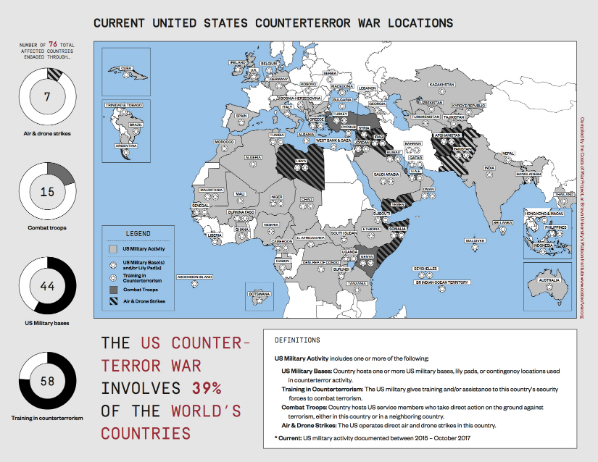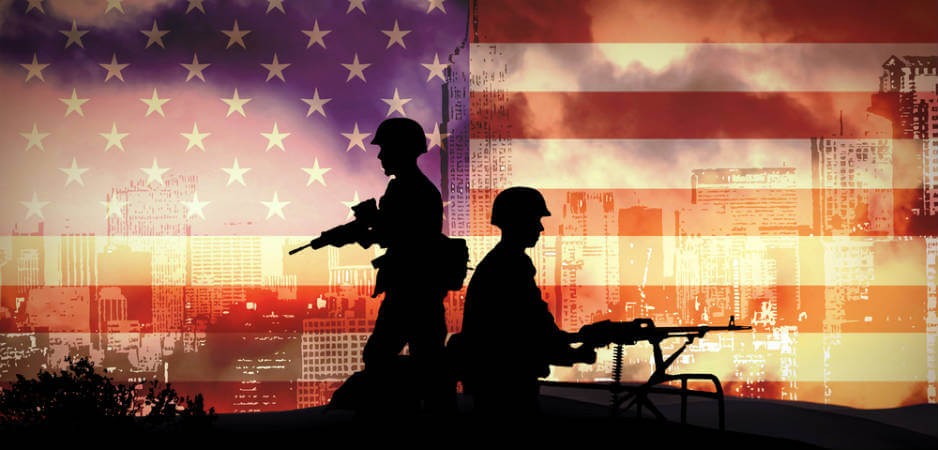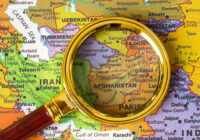America’s war on terror has now spread to 76 countries across the globe.
He left Air Force Two behind and, unannounced, “shrouded in secrecy,” flew on an unmarked C-17 transport plane into Bagram Air Base, the largest American garrison in Afghanistan. All news of his visit was embargoed until an hour before he was to depart the country.
More than 16 years after an American invasion “liberated” Afghanistan, he was there to offer some good news to a US troop contingent, once again on the rise. Before a 40-foot American flag, addressing 500 American troops, Vice President Mike Pence praised them as “the world’s greatest force for good,” boasted that American air strikes had recently been “dramatically increased,” swore that their country was “here to stay,” and insisted that “victory is closer than ever before.” As an observer noted, however, the response of his audience was “subdued.” (“Several troops stood with their arms crossed or their hands folded behind their backs and listened, but did not applaud.”)
Think of this as but the latest episode in an upside down geopolitical fairy tale, a grim, rather than Grimm, story for our age that might begin: Once upon a time —in October 2001, to be exact — Washington launched its war on terror. There was then just one country targeted, the very one where, a little more than a decade earlier, the US had ended a long proxy war against the Soviet Union, during which it had financed, armed or backed an extreme set of Islamic fundamentalist groups, including a rich young Saudi by the name of Osama bin Laden.
By 2001, in the wake of that war, which helped send the Soviet Union down the path to implosion, Afghanistan was largely (but not completely) ruled by the Taliban. Osama bin Laden was there, too, with a relatively modest crew of cohorts. By early 2002, he had fled to Pakistan, leaving many of his companions dead and his organization, al-Qaeda, in a state of disarray. The Taliban, defeated, was pleading to be allowed to put down its arms and go back to the villages, an abortive process that Anand Gopal vividly described in his book, No Good Men Among the Living.
It was, it seemed, all over, but the cheering and, of course, the planning for yet greater exploits across the region. The top officials in the administration of President George W. Bush and Vice President Dick Cheney were geopolitical dreamers of the first order who couldn’t have had more expansive ideas about how to extend such success to — as Secretary of Defense Donald Rumsfeld indicated only days after the 9/11 attacks — terror or insurgent groups in more than 60 countries. It was a point President Bush would reemphasize nine months later in a triumphalist graduation speech at West Point.
At that moment, the struggle they had quickly, if immodestly, dubbed the global war on terror was still a one-country affair. They were, however, already deep into preparations to extend it in ways more radical and devastating than they could ever have imagined with the invasion and occupation of Saddam Hussein’s Iraq and the domination of the oil heartlands of the planet that they were sure would follow. (In a comment that caught the moment exactly, Newsweek quoted a British official “close to the Bush team” as saying, “Everyone wants to go to Baghdad. Real men want to go to Tehran.”)
So many years later, perhaps it won’t surprise you — as it probably wouldn’t have surprised the hundreds of thousands of protesters who turned out in the streets of American cities and towns in early 2003 to oppose the invasion of Iraq — that this was one of those stories to which the adage “be careful what you wish for” applies.
Seeing War
It is a tale that’s not over yet — not by a long shot. As a start, in the Trump era, the longest war in American history, the one in Afghanistan, is only getting longer. There are those US troop levels on the rise; those air strikes ramping up; the Taliban in control of significant sections of the country; an Islamic State-branded terror group spreading ever more successfully in its eastern regions; and, according to the latest report from the Pentagon, “more than 20 terrorist or insurgent groups in Afghanistan and Pakistan.”
Think about that: 20 groups. In other words, so many years later, the war on terror should be seen as an endless exercise in the use of multiplication tables, and not just in Afghanistan either. More than a decade and a half after an American president spoke of 60 or more countries as potential targets, thanks to the invaluable work of a single dedicated group, the Costs of War Project at Brown University’s Watson Institute for International and Public Affairs, we finally have a visual representation of the true extent of the war on terror. That we’ve had to wait so long should tell us something about the nature of this era of permanent war.
 The Costs of War Project has produced not just a map of the war on terror, 2015-2017, but the first map of its kind ever. It offers an astounding vision of Washington’s counterterror wars across the globe: their spread, the deployment of US forces, the expanding missions to train foreign counterterror forces, the American bases that make them possible, the drone and other air strikes that are essential to them and the US combat troops helping to fight them. (Terror groups have, of course, morphed and expanded riotously as part and parcel of the same process.)
The Costs of War Project has produced not just a map of the war on terror, 2015-2017, but the first map of its kind ever. It offers an astounding vision of Washington’s counterterror wars across the globe: their spread, the deployment of US forces, the expanding missions to train foreign counterterror forces, the American bases that make them possible, the drone and other air strikes that are essential to them and the US combat troops helping to fight them. (Terror groups have, of course, morphed and expanded riotously as part and parcel of the same process.)
A glance at the map tells you that the war on terror, an increasingly complex set of intertwined conflicts, is now a remarkably global phenomenon. It stretches from the Philippines (with its own ISIS-branded group that just fought an almost five-month-long campaign that devastated Marawi, a city of 300,000) through South Asia, Central Asia, the Middle East, North Africa and deep into West Africa where, only recently, four Green Berets died in an ambush in Niger.
No less stunning are the number of countries Washington’s war on terror has touched in some fashion. Once, of course, there was only one (or, if you want to include the United States, two). Now, the Costs of War Project identifies no less than 76 countries, 39% of those on the planet, as involved in that global conflict. That means places like Afghanistan, Syria, Iraq, Yemen, Somalia and Libya where US drone or other air strikes are the norm, and US ground troops (often Special Operations Forces) have been either directly or indirectly engaged in combat. It also means countries where US advisers are training local militaries or even militias in counterterror tactics and those with bases crucial to this expanding set of conflicts. As the map makes clear, these categories often overlap.
The Price Tag
Who could be surprised that such a “war” has been eating American taxpayer dollars at a rate that should stagger the imagination in a country whose infrastructure is now visibly crumbling? In a separate study, released in November, the Costs of War Project estimated that the price tag on the war on terror (with some future expenses included) had already reached an astronomical $5.6 trillion. Only recently, however, President Trump, now escalating those conflicts, tweeted an even more staggering figure: “After having foolishly spent $7 trillion in the Middle East, it is time to start rebuilding our country!” (This figure, too, seems to have come in some fashion from the Costs of War estimate that “future interest payments on borrowing for the wars will likely add more than $7.9 trillion to the national debt” by mid-century.)
It couldn’t have been a rarer comment from an American politician, as in these years assessments of both the monetary and human costs of war have largely been left to small groups of scholars and activists. The war on terror has, in fact, spread in the fashion today’s map lays out with almost no serious debate in this country about its costs or results. If the document produced by the Costs of War project is, in fact, a map from hell, it is also, I believe, the first full-scale map of this war ever produced.
Think about that for a moment. For the last 16 years, we, the American people, funding this complex set of conflicts to the tune of trillions of dollars, have lacked a single map of the war Washington has been fighting. Not one. Yes, parts of that morphing, spreading set of conflicts have been somewhere in the news regularly, though seldom (except when there were lone wolf terror attacks in the United States or Western Europe) in the headlines. In all those years, however, no American could see an image of this strange, perpetual conflict the end of which is nowhere in sight.
Part of this can be explained by the nature of that “war.” There are no fronts, no armies advancing on Berlin, no armadas bearing down on the Japanese homeland. There hasn’t been, as in Korea in the early 1950s, even a parallel to cross or fight your way back to. In this war, there have been no obvious retreats and, after the triumphal entry into Baghdad in 2003, few advances either.
It was hard even to map its component parts and when you did — as in an August New York Times map of territories controlled by the Taliban in Afghanistan — the imagery was complex and of limited impact. Generally, however, we, the people, have been demobilized in almost every imaginable way in these years, even when it comes to simply following the endless set of wars and conflicts that go under the rubric of the war on terror.
Let me repeat this mantra: Once, almost 17 years ago, there was one; now, the count is 76 and rising. Meanwhile, great cities have been turned into rubble; tens of millions of human beings have been displaced from their homes; refugees by the millions continue to cross borders, unsettling ever more lands; terror groups have become brand names across significant parts of the planet; and our American world continues to be militarized.
This should be thought of as an entirely new kind of perpetual global war. Take one more look at that map. Click on it and then enlarge it to consider the map in full-screen mode. It’s important to try to imagine what’s been happening visually, since we’re facing a new kind of disaster, a planetary militarization of a sort we’ve never truly seen before. No matter the “successes” in Washington’s war, ranging from that invasion of Afghanistan in 2001 to the taking of Baghdad in 2003 to the recent destruction of the Islamic State’s “caliphate” in Syria and Iraq (or most of it anyway, since at this moment American planes are still dropping bombs and firing missiles in parts of Syria), the conflicts only seem to morph and tumble on.
The Only Edge
We are now in an era in which the US military is the leading edge — often the only edge — of what used to be called American “foreign policy” and the State Department is being radically downsized. American Special Operations Forces were deployed to 149 countries in 2017 alone, and the US has so many troops on so many bases in so many places on Earth that the Pentagon can’t even account for the whereabouts of 44,000 of them. There may, in fact, be no way to truly map all of this, though the Costs of War Project’s illustration is a triumph of what can be seen.
Looking into the future, let’s pray for one thing — that the folks at that project have plenty of stamina, since it’s a given that, in the Trump years (and possibly well beyond), the costs of war will only rise. The first Pentagon budget of the Trump era, passed with bipartisan unanimity by Congress and signed by the president, is a staggering $700 billion. Meanwhile, America’s leading military men and the president, while escalating the country’s conflicts from Niger to Yemen, Somalia to Afghanistan, seem eternally in search of yet more wars to launch.
Pointing to Russia, China, Iran and North Korea, for instance, Marine Corps Commandant General Robert Neller recently told US troops in Norway to expect a “bigass fight” in the future, adding, “I hope I’m wrong, but there’s a war coming.” In December, National Security Adviser Lieutenant General H.R. McMaster similarly suggested that the possibility of a war (conceivably nuclear in nature) with Kim Jong-un’s North Korea was “increasing every day.” Meanwhile, in an administration packed with Iranophobes, President Trump seems to be preparing to tear up the Iran nuclear deal, possibly as early as this month.
In other words, in 2018 and beyond, maps of many creative kinds may be needed simply to begin to take in the latest in America’s wars. Consider, for instance, a recent report in The New York Times that about 2,000 employees of the Department of Homeland Security are already “deployed to more than 70 countries around the world,” largely to prevent terror attacks. That is how it goes in the 21st century.
So welcome to 2018, another year of unending war. While we’re on the subject, a small warning to our leaders: Given the last 16 years, be careful what you wish for.
*[This article was originally published by TomDispatch.]
The views expressed in this article are the author’s own and do not necessarily reflect Fair Observer’s editorial policy.
Photo Credit: Benjamin Haas / Shutterstock.com
Support Fair Observer
We rely on your support for our independence, diversity and quality.
For more than 10 years, Fair Observer has been free, fair and independent. No billionaire owns us, no advertisers control us. We are a reader-supported nonprofit. Unlike many other publications, we keep our content free for readers regardless of where they live or whether they can afford to pay. We have no paywalls and no ads.
In the post-truth era of fake news, echo chambers and filter bubbles, we publish a plurality of perspectives from around the world. Anyone can publish with us, but everyone goes through a rigorous editorial process. So, you get fact-checked, well-reasoned content instead of noise.
We publish 2,500+ voices from 90+ countries. We also conduct education and training programs
on subjects ranging from digital media and journalism to writing and critical thinking. This
doesn’t come cheap. Servers, editors, trainers and web developers cost
money.
Please consider supporting us on a regular basis as a recurring donor or a
sustaining member.
Will you support FO’s journalism?
We rely on your support for our independence, diversity and quality.






